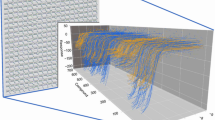Abstract
The nature of high-throughput screening (HTS) puts certain limits on optimal test conditions for each particular sample, therefore, on top of usual data normalization, additional parsing is often needed to account for incomplete read outs or various artifacts that arise from signal interferences.
CurveP is a heuristic, user-tunable, curve-cleaning algorithm that attempts to find a minimum set of corrections, which would give a monotonic dose–response curve. After applying the corrections, the algorithm proceeds to calculate a set of numeric features, which can be used as a fingerprint characterizing the sample, or as a vector of independent variables (e.g., molecular descriptors in case of chemical substances testing). The resulting output can be a part of HTS data analysis or can be used as input for a broad spectrum of computational applications, such as Quantitative Structure-Activity Relationship (QSAR) modeling, computational toxicology, bio- and cheminformatics.
Access this chapter
Tax calculation will be finalised at checkout
Purchases are for personal use only
Similar content being viewed by others
References
Pereira DA, Williams JA (2007) Origin and evolution of high throughput screening. Br J Pharmacol 152:53–61
Inglese J, Auld DS, Jadhav A et al (2006) Quantitative high-throughput screening: a titration-based approach that efficiently identifies biological activities in large chemical libraries. Proc Natl Acad Sci U S A 103:11473–11478
Hsieh JH, Sedykh A, Huang R et al (2015) A data analysis pipeline accounting for artifacts in Tox21 quantitative high-throughput screening assays. J Biomol Screen 20:887–897
Sedykh A, Zhu H, Tang H et al (2011) Use of in vitro HTS-derived concentration–response Data as biological descriptors improves the accuracy of QSAR models of in vivo toxicity. Environ Health Perspect 119:364–370
Lock EF, Abdo N, Huang R et al (2012) Quantitative high-throughput screening for chemical toxicity in a population-based in vitro model. Toxicol Sci 126:578–588
Low Y, Sedykh A, Fourches D et al (2013) Integrative chemical-biological read-across approach for chemical hazard classification. Chem Res Toxicol 26:1199–1208
Sprague B, Shi Q, Kim MT et al (2014) Design, synthesis and experimental validation of novel potential chemopreventive agents using random forest and support vector machine binary classifiers. J Comput Aided Mol Des 28:631–646
Sedykh A, Low Y, Lock E et al. (2012) Using population-based dose-response cytotoxicity data for in silico prediction of rat acute toxicity. Abstracts of Papers, 51th SOT National meeting, San Francisco, CA, March 11–15
Author information
Authors and Affiliations
Corresponding author
Editor information
Editors and Affiliations
Rights and permissions
Copyright information
© 2016 Springer Science+Business Media New York
About this protocol
Cite this protocol
Sedykh, A. (2016). CurveP Method for Rendering High-Throughput Screening Dose-Response Data into Digital Fingerprints. In: Zhu, H., Xia, M. (eds) High-Throughput Screening Assays in Toxicology. Methods in Molecular Biology, vol 1473. Humana Press, New York, NY. https://doi.org/10.1007/978-1-4939-6346-1_14
Download citation
DOI: https://doi.org/10.1007/978-1-4939-6346-1_14
Published:
Publisher Name: Humana Press, New York, NY
Print ISBN: 978-1-4939-6344-7
Online ISBN: 978-1-4939-6346-1
eBook Packages: Springer Protocols



